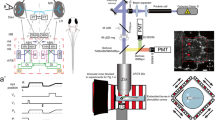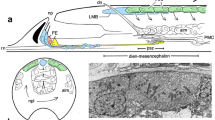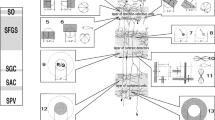Summary
The dioptrics of the Musca ommatidium acts as an inverting lens system. The distal endings of the rhabdomeres at the basis of the dioptric apparatus are separated and arranged in a typical asymmetric pattern. The optical axes of the individual rhabdomeres of one ommatidium are the geometric projections of the distal rhabdomere endings into the environment, inverted by 180° by the dioptric apparatus. The divergence angles between the optical axes of the rhabdomeres of one ommatidium correspond to divergence angles between the appropriate set of ommatidia in such a way, that seven rhabdomeres of seven ommatidia are looking at one point in the environment (in the intermediate region between dorsal and ventral part of the eye: eight to nine rhabdomeres of a set of eight to nine ommatidia). These facts were established from sections of living eyes and confirmed by using special optical methods in the intact animal.
The pattern of the decussation of individual retinulacell axons between retina and lamina was predicted adopting the hypothesis that the fibres of retinulacells number one to six, whose rhabdomers are looking at one point in the environment, project into a single “cartridge” in the lamina. These predicted connections were confirmed by other investigators. We have therefore a one to one correspondence between a lattice of points in the environment and the lattice of “cartridges” in the lamina.
It is shown that the unfused rhabdomeric structure of the Musca ommatidium increases the effective entrance pupil of the eye by a factor of seven (resp. eight to nine in the intermediate region between dorsal and ventral part of the eye) compared to the classical apposition eye. —The Musca compound eye can be regarded as a “neural superposition eye”.
Similar content being viewed by others
Literatur
Autrum, H.J., u. I. Wiedemann: Versuche über den Strahlengang im Insektenauge (Appositionsauge). Z. Naturforsch. 17 b, 480–482 (1962).
Bernhard, C.G., W.H. Miller and A.R. M}:oller: The insect corneal nipple array. Acta physiol. scand. 63, Suppl. 243 (1965).
Braitenberg, V.: Unsymmetrische Projektion der Retinulazellen auf die Lamina ganglionaris bei der Fliege Musca domestica. Z. vergl. Physiol. 50, 212–214 (1966).
— Patterns of projection in the visual system of the fly. I. Retina-Lamina projections. Exp. Brain Res. 3, 271–298 (1967).
Burkhardt, D.: Spectral sensitivity and other response characteristics of single visual cells in the arthropod eye. Symp. Soc. exp. Biol. XVI, 86–109 (1962).
Burtt, E.T., and W.T. Catton: A diffraction theory of insect vision. I. An experimental investigation of visual acuity and image formation in the compound eyes of three species of insects. Prov. roy. Soc. B 157, 53–82 (1962).
Dietrich, W.: Die Fazettenaugen der Dipteren. Z. wiss. Zool. 92, 465–539 (1909).
Exner, S.: Die Physiologie der fazettierten Augen von Krebsen und Insekten. Leipzig und Wien: Deutike 1891.
Götz, K.G.: Optomotorische Untersuchungen des visuellen Systems einiger Augenmutanten der Fruchtfliege Drosophila. Kybernetik 2, 77–92 (1964).
— Die optischen:Ubertragungseigenschaften der Komplexaugen von Drosophila. Kybernetik 2, 215–221 (1965).
Hassenstein, B.: Ommatidienraster und afferente Bewegungsintegration. Versuche an dem Rüsselkäfer Chlorophanus viridis. Z. vergl. Physiol. 33, 301–326 (1951).
—, u. W. Reichardt: Systemtheoretische Analyse der Zeit-, Reihenfolgen-und Vorzeichen auswertung bei der Bewegungsperzeption des Rüsselkäfers Chlorophanus. Z. Naturforsch. 11b, 513–524 (1956).
Hecht, S., S. Shlaer and M.H. Pirenne: Energy, quanta and vision. J. gen. Physiol. 25, 819–840 (1942).
Hohmann, H.: Der Vertikalilluminator als Augenspiegel bei kleinen Augen. Biol. Zbl. 44, 582–592 (1924).
— Beiträge zur Physiologie der Spinnenaugen. I. Untersuchungsmethoden. II. Das Sehver-mögen der Salticiden. Z. vergl. Physiol. 7, 201–268 (1928).
Kirschfeld, K.: Das anatomische und das physiologische Sehfeld der Ommatidien im Komplexauge von Musca. Kybernetik 2, 249–257 (1965a).
— Discrete and graded receptor potentials in the compound eye of the fly (Musca). The Functional Organization of the Compound Eye. Proceedings of the International Symposium held in Stockholm, October 1965b, Wenner-Gren Center. International Symposium Series 7, Pergamon Press, Oxford.
—, u. W. Reichardt: Die Verarbeitung stationärer optischer Nachrichten im Komplexauge von Limulus (Ommatidien Sehfeld und räumliche Verteilung der Inhibition). Kybernetik 2, 43–61 (1964).
Kuiper, J.W.: The optics of the compound eye. Symp. Soc. exp. Biol. 16, 58 (1962).
Langer, H., and B. Thorell: Microspectrophotometry of single rhabdomeres in the insect eye. Exp. Cell. Res. (1966) (in print).
McCann, G.D., and G.F. MacGinitie: Optomotor response studies of insect vision. Proc. roy. Soc. B163, 369–401 (1965).
Meyer, G.F.: Versuch einer Darstellung von Neurofibrillen im zentralen Nervensystem verschiedener Insekten. Zool. Jb. Anatomie 71, 413–426 (1951).
Palka, J.: Diffraction and visual acuity of insects. Science 149, 551–553 (1965).
Reichardt, W.: Autokorrelations-Auswertung als Funktionsprinzip des Zentralnervensystems (bei der optischen Bewegungswahrnehmung eines Insekts). Naturforsch. 12 b, 448–457 (1957).
—, u. D. Varju: Übertragungseigenschaften im Auswertesystem für das Bewegungssehen (Folgerungen aus Experimenten an dem Rüsselkäfer Chlorophanus viridis). Z. Naturforsch. 14 b, 674–689 (1959).
Rein, H., u. M. Schneider: Einführung in die Physiologie des Menschen. Berlin-Göttingen-Heidelberg: Springer 1956.
Schneider, L., u. H. Langer: Die Feinstruktur des Überganges zwischen Kristallkegel und Rhabdomeren im Facettenauge von Calliphora. Z. Naturforsch. 21 b, 196–197 (1966).
Stockhammer, K.: Zur Wahrnehmung der Schwingungsrichtung linear polarisierten Lichtes bei Insekten. Z. vergl. Physiol. 38, 30–83 (1956).
Thorson, J.: Small-signal analysis of a visual reflex in the Locust. I. Input parameters. Kybernetik 3, 41–53 (1966a).
— Small-signal analysis of a visual reflex in the Locust. II. Frequency dependence. Kybernetik 3, 53–66 (1966b).
Trujillo-Cenóz, O.: Some aspects of the structural organization of the intermediate retina of dipterans. J. Ultrastruct. Res. 13, 1–33 (1965).
Trujillo-Cenóz, O., Compound eye of dipterans: Anatomical basis for integration. An electron microscope study. J. Ultrastruct. Res. (1966) (in print).
—, J. Melamed: Electron microscope observations on the peripheral and intermediate retinas of dipterans. The Functional Organization of the Compound Eye. Proceedings of the International Symposium held in Stockholm, October 1965, Wenner-Gren Center. International Symposium Series 7, Pergamon Press, Oxford.
Vowles, D.M.: The receptive fields of cells in the retina of the housefly (Musca domestica). Proc. roy. Soc. B164, 552–576 (1966).
Washizu, Y., D. Burkhardt and P. Streck: Visual field of single retinula cells in the compound eye of the blowfly. Z. vergl. Physiol. 48, 413–428 (1964).
Wolken, J.J.: Structure and molecular organization of retinal photoreceptors. J. opt. Soc. Amer. 53, 1–19 (1963).
Author information
Authors and Affiliations
Additional information
Mit Unterstützung durch die Stiftung Volkswagenwerk.
Rights and permissions
About this article
Cite this article
Kirschfeld, K. Die projektion der optischen umwelt auf das raster der rhabdomere im komplexauge von Musca. Exp Brain Res 3, 248–270 (1967). https://doi.org/10.1007/BF00235588
Received:
Issue Date:
DOI: https://doi.org/10.1007/BF00235588




